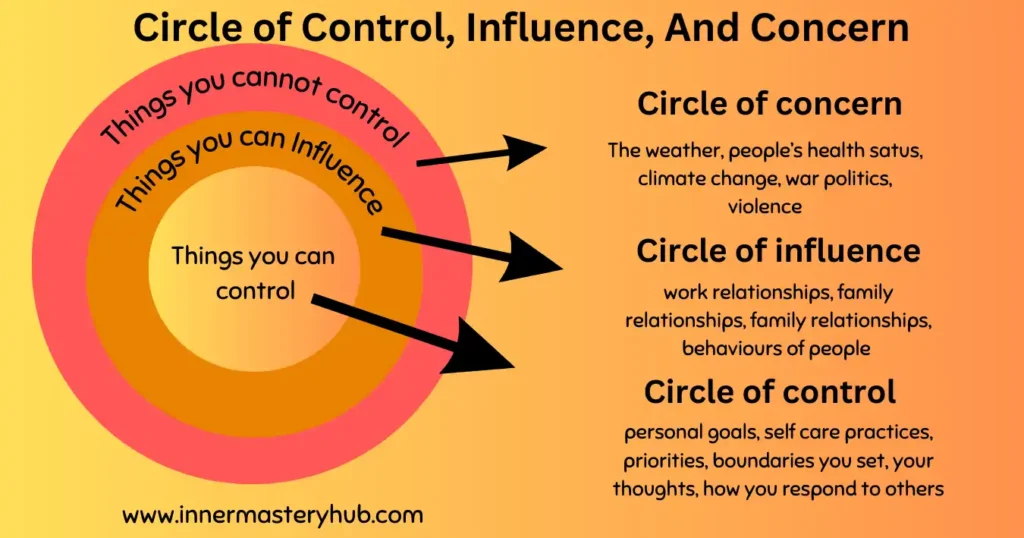Circle of Control, Influence, And Concern: Master the Control Dynamics

I strongly believe in establishing a balance in all spheres of life. I don’t try to control the events of my life; rather, I let everything flow naturally and try to put the best in my capacity in every aspect of my life. That is what I have learned by going through different challenges in life.
I do whatever is possible in my capacity and let things fall naturally. That’s what is referred to as a circle of control. When you are loyal to your work by detaching yourself from the outcome, putting in hard work, and leaving the rest to nature, the outcome tends to turn out positively.
Stephen Covey articulated this point well in his book “The Seven Habits of Highly Effective People” by using the concepts of proactive and reactive focus, as well as the different circles between our circle of Concern and our circle of Influence. There is no need to worry about the outcomes of your job or the circle outside your circle of Influence or control. It only triggers anxiety and detracts you from your job of proactive focus.
I have always observed, through working with different people, that those who embrace change can focus on the things within their control instead of wasting their time and energy on things outside their Influence. If you follow this course of action, things will naturally transform for you.
In this article, we will explore how to leverage the concept of the “circle of control and circle of influence model.”
Understanding the Theory: A Model and Diagram
Stoic philosophers Seneca, Epictetus, and Marcus Aurelius believed that we can lead fulfilling lives by focusing on and maintaining energy for the things we can control. Psychologists have expanded on the two spheres of control and included the “circle of influence” in the gray area of the model, delineating what we can and cannot control.
Some things about human nature are within our control and capacity, while others are not, according to Epictetus (2009, p. 135). Our body, possessions, reputation, standing, and anything else in human nature that is not our thinking and doing are not under our thinking and power; nevertheless, our thinking, opinion, motivation, desire, and aversion are.
The Stoics agreed that our thoughts, emotions, interpretations, actions, and reactions are always within our circle of control, and we should work on these factors to improve them. By contrast, Certain things are outside our control, like random life events, the economy, and other people’s actions, feelings, and opinions. These are the things that we can’t control and need not worry about.
Nisbett emphasizes the difficulty of comprehending the circle of control in his 2003 publication, particularly in a world where the need for control is ubiquitous. He notably mentions how most people from Western cultures frequently exaggerate their capacity for Influence and control over various facets of daily life.
The “Circle of Influence” paradigm, often illustrated by two concentric rings, helps identify the aspects of one’s life over which one has control or influence. The inner circle, also known as the “Circle of Influence,” includes parts of our lives over which we have direct control, such as our ideas, actions, attitudes, and Circlet.
The outer circle of influence, known as the “Circle of Concern,” encompasses elements over which we have no direct control, such as global events or the activities of others. By focusing our energy and attention on our Circle of Influence, we can make significant changes while avoiding the stress and frustration that often come with worrying about things beyond our control.
In the diagram above, you can see three circles embedded within each other.
Aspects of our lives that we have direct control over are represented by the Circle and the smallest circle in the Circle, which is the circle of control. It is the area where transformation is possible. The circle of control represents the point at which we can take significant action and make improvements.
The junction of things directly under our immediate control and those out of our direct control is shown by the second, slightly wider Circle, called the Circle of Influence. This zone allows Circleo to expand our circle of Influence and create change.
While we can’t control the outcomes, investing our energies in this sphere where we control our efforts is wise. Let’s embrace the challenge and make a positive difference here.
The diagram’s third and outermost circle represents the “CircleCirclencern.” This circle encompasses our concern and includes a broader range of external events, factors, challenges, and circumstances that we may genuinely care about but are beyond our control.
These causes include macro-level elements such as government policy, the global economy’s response to the epidemic, climate change, weather patterns, and the actions, emotions, behaviors, and sentiments of others.
In his 2016 book (p. xi), author Ryan Holiday wrote, “We cannot control the world around us, but we can control our reactions to it.” The adoption of this concept in our own lives has yielded considerable results.
For example, a study by Luthans et al. (2008, p. 132) found that “individuals who focus on the circle of influence they control are more likely to exhibit resilience in the face of stress and adversity.”
This emphasizes the significance of directing our efforts toward our Circle of Influence while remaining mindful of our Circle of Concern.
The circle of control is a useful cognitive tool for helping individuals manage their emotional responses to challenging situations.
Circle of Concern vs. Circle of Influence
The “Circle of Concern” and “Circle of Influence” cover many things, some of which we cannot control. Geopolitical events, environmental issues, and other decisions are examples.
We may be passionate about issues, but we cannot always change them. You may worry about a family member’s money or health, but what can you do?
The Circle of Influence covers areas we directly control, such as personal habits and reactions. Concentrating on our Circle of Influence inspires and gives us control by enabling us to make meaningful life adjustments.
According to the idea, people who focus on their Circle of Influence rather than Circle of Concern are happier and more successful. They are active and don’t let others decide their happiness or peace.
They realize their actions and thoughts affect their surroundings.
However, those who dwell on their Circle of Concern often feel weak or overwhelmed trying to control the unpredictable. Diversity and concentration help us regulate our focus and attention for a better, more fulfilling life.
Circle of Influence example
Consider a firm employee concerned about the environmental impact of their work. This topic falls within their Circle of Concern because they cannot change the company’s environmental policy alone.
However, they can promote recycling, paper reduction, and energy efficiency within their department or team, which falls within their Circle of Influence.
They can effectively address their concern and expand their workplace Circle of Influence by focusing on these achievable and beneficial characteristics. It illustrates how we can utilize our Circle of Influence to address broader concerns within our Circle of Concern.
Proactive people
Proactive people demonstrate the value of the Circle of Influence. They focus on areas where they can make a difference, establishing control and empowerment. They recognize that their behaviors and attitudes can impact their environment and experiences.
Proactivity enables people to solve problems and transform challenges into opportunities. They anticipate and solve problems rather than reacting. Proactive individuals who stayed within their Circle of Influence gradually gained more control over various aspects of human nature.
Reactive People
Reactive individuals focus on their Circle of Concern, whereas proactive individuals focus on their Circle of Influence. People are often swayed by external factors rather than taking charge of their actions.
Their circumstances affect their mood, and they often feel overwhelmed, unable to act, and frustrated because they feel powerless.
Responders worry about external events, such as the actions of others or global disasters. Their thinking is defensive, responding to the reality rather than changing it.
They often feel stuck because they think their happiness and success depend on others rather than their actions and attitudes. This misplaced negativity held them in their Circle of Concern, limiting their Circle of Influence.
Assume a reactive person is concerned about their company’s new business or government policy’s environmental impact, like the proactive person. In such instances, they may dispute workplace policies or feel helpless.
Instead of taking action in their Circle of Influence, they fret, feeling frustrated and powerless.
We can better regulate our proactive focus and reactions when we comprehend the interactions between the three circles of concern, influence, and control. By working diligently and investing our time and energy in areas that we can influence and control, we can effectively tackle life’s challenges, capitalize on opportunities, and ultimately shape the path of our journey.
The Circle of Concern
The Circle of Control is nested within the Circle of Influence, illustrating that our actions and attitudes have an impact on our influence. Work ethic and health behaviors significantly impact both professional and physical health.
Responding constructively to criticism, eating healthily, and investing in professional progress are examples of Circle of Control, actions that reflect our values and goals.
Understanding how Concern, Influence, and Control interact enables us to focus and take effective action. Staying focused on our options helps us overcome challenges, seize opportunities, and build our destiny.
The Circle of Concern covers human issues. Sustainability, politics, economics, and local issues like traffic, job stability, and health are among these concerns. Despite caring about these issues, we have little control over them.
Overworking the Circle of Concern can lead to feelings of powerlessness, conflict, and discontent. We must be aware of these issues, but not allow them to overwhelm us. Finding and focusing on the Circle of Influence and Control helps improve life.
One step further – The Circle of Control
It’s natural to care about big concerns, but we should also control what we can. Thoughts, actions, and decisions shape lives. Joining this Circle of Control and taking responsibility improves us.
Our entirely autonomous behaviors, attitudes, and choices are shown in the Circle of Control. Our direct power over these elements shapes our lives. Consider its entire circle of Influence: it creates opportunities, maintains values, and maximizes potential. Personal growth and fulfillment depend on our Circle of Control, which promotes responsibility and proactive living.
For you or with your team – Circle of Influence Exercise
Ready to level up your team’s performance? Give the Circle of Influence exercise a try! Here’s how it works:
- Grab a large sheet and draw two concentric circles.
- Jot down elements your team can co-circle in the inner circle, like collaboration and communication.
- Note areas of InflCircle in the outer circle, such as team culture and relationships with other departments.
- Acknowledge what your team can’t control, suchas company policies or market trends, outside of these areass
- Watch your team identify where to spend energy, fostering proactivity and effective teamwork.
- Empower your team to make a real impact!
Circle of concern example
Everything you care about, such as world concerns or the perspectives of others, but aren’t always able to influence, is included in the Circle of Concern. For instance, worrying about a friend’s decisions or world famine. To lessen stress and make a difference, concentrate on the things you can control, such as your behavior.
Applying the Theory: 3 Real-Life Examples

Michael Jordan. A healthy mindset and persistence are emblematic of the professional basketball player. Jordan continued to practice and improve after being cut from his high school basketball team. His perseverance and trust in his ability to enhance made him a basketball icon and a champion of the growth mindset.
Thomas Edison exemplifies attention and proactivity. Despite his many failed attempts to invent the light bulb, he kept working toward his goal. Edison’s persistence in testing new materials until he succeeded shows proactive conduct.
Oprah Winfrey. Her rags-to-riches journey shows how to enlarge one’s Circle of Control. Despite several early setbacks, she took charge of her life, made strategic decisions that supported her future goals, and pursued her media passion aggressively. Her rise from poverty to media queen shows the power of a purposeful Circle of Control expansion.
Where Should You Focus Your Energy?
Energy focus is needed to succeed. Focus on your passions, values, and strengths—what makes you unique. Consider the Circle of Control aspects you can control.
Overthinking how much time and energy you spend worrying about outside circumstances might lead to frustration and stagnation. Stop worrying and focus on personal growth, learning, and enriching relationships. Energy flows where you focus.
Proactive Mindset vs. Reactive Mindset
Predicting, bringing about change, and accepting accountability are all components of proactive thinking. Those in leadership roles make things happen. Thinking reactively responds to the surroundings.
Reactive individuals tend to react rather than influence situations because they perceive themselves as victims. While reactive people deal with the now, proactive people think about the future. Self-actualization is the result of proactive thinking.
Develop a growth mentality.
Having an outlook on growth means viewing challenges as opportunities to improve. The most important things are perseverance, viewing criticism as constructive feedback, and embracing failure as a stepping stone to mastery.
Celebrate the achievements of others because they can motivate you. Never give up; you can get better with perseverance, attention, and persistence. Let’s begin to better ourselves!
“I am not a product of my circumstances. I am a product of my decisions.” — Dr. Stephen Covey
Famous educator, author, and speaker Stephen R. Covey observed, “I am not my circumstances. Choices shape me.” The statement emphasizes our choices and the ability to shape our destiny. Our path is shaped by the choices we make and the circumstances we encounter.
Decisions can change our experiences, rather than absorb them. We must control our own fate and happiness, rather than being victims. Choices, not circumstances, shape our lifestyle. To live our dream life, we must make decisions that align with our beliefs, passions, and goals.
Find Your Purpose
Finding your purpose requires soul-searching and discovering your passion. Consider what motivates and interests you. These can show your intent.
Your purpose guides you toward your goals. It can inspire and satisfy you in even the most challenging circumstances. Consider your purpose discovery a personal growth adventure.
Challenge Your Limits
Reaching our potential requires removing limiting beliefs. Our beliefs can be shaped by our past, which can restrict our advancement. Self-criticism and mistrust result from their influence on our worldview. These views aren’t final. We must acknowledge and face them to deconstruct them.
Are these beliefs true or assumptions? Do they help or hinder? Replace limiting beliefs with liberating ones. Opt “I’m not capable of success” w “I possess the boundless potential to conquer anything I set my mind to.” Through conscious thought reframing, we overcome limiting beliefs and gain power. Let go!
Applying the Circle of Control in Life
Exploring purpose is thrilling. Imagine our unexplored sweet spot—where our interests, skills, and the world’s needs meet. Passions drive us. We show our superpowers and abilities.
We conclude by considering global needs and exploring how we can contribute. Discover significance and fulfillment by focusing on this pivotal moment. Legacy can come from this adventure. Prepared? Let’s start!
How to Expand Your Circles of Control
First, discover health or career changes to enlarge your Circle of Control. For optimal health, eat a balanced diet and engage in regular exercise.
Create a growth mentality, seeing obstacles as learning opportunities. Controlling more doesn’t equal controlling everything.
Instead, it’s about responding well and focusing on what you can control, which enhances personal growth and overall life satisfaction. This proactive strategy enables you to shape your own fate.
FAQS About Circle of Control vs. Circle of Influence
What is the Circle of Control?
Your thoughts, deeds, and choices are among the things in the Circle of Control that you have direct control over. Focus here on what you can change, such as your attitude or daily routine, rather than outside influences, which increases personal empowerment, lowers stress, and boosts productivity.
What is the Circle of Influence?
The Circle of Influence encompasses aspects such as relationships and work outcomes that you can indirectly influence. You can increase your influence and promote positive change without having complete control by concentrating on actions and communication. For example, you might encourage improved team morale or collaboration.
How do the Circle of Control and Circle of Influence differ?
Direct activities, like your behavior, are included in the Circle of Control, whereas areas that you can indirectly influence, like other people’s decisions, are included in the Circle of Influence. While influence necessitates communication and persuasion and affects wider results, control is instantaneous and personal.
What is the Circle of Concern?
Things that you care about but cannot influence, such as the weather or world events, are included in the Circle of Concern. Living here makes you more stressed. By focusing on the Circles of Control and Influence, anxiety is reduced and proactive action is encouraged.
How can the Circle of Control reduce stress?
By focusing on doable behaviors and concentrating on the Circle of Control—such as managing your time or reactions—stress can be reduced. Resilience and a sense of empowerment are fostered by releasing mental energy from uncontrollable worries, such as those related to other people’s opinions.
How can I expand my Circle of Influence?
Increase your Circle of Influence through skill development, relationship building, and better communication. By taking proactive steps, such as networking or idea sharing, you can progressively move problems into areas where you can influence others’ decisions.
Why is focusing on the Circle of Concern harmful?
Like worrying about the economy, concentrating on the Circle of Concern saps energy and raises anxiety without producing results. It encourages powerlessness. Productivity and mental health are improved by shifting attention to influence and control.
How can I apply these circles to my daily life?
Put the worries into three categories using the circles: control (like your effort), influence (like team dynamics), and concern (like the weather). To be proactive, take action on things you can influence and control while letting go of worries.
How do these circles apply to leadership?
Leaders use the circles to concentrate on influence (e.g., team morale) and controlled actions (e.g., decision-making). This enhances strategic effectiveness and team engagement without diverting attention to outside variables, such as market conditions.
What’s the Stoic connection to these circles?
The circles stress control over one’s ideas and deeds, which is consistent with Stoic philosophy (Epictetus, Marcus Aurelius). Effective decision-making and inner serenity are fostered by accepting what is beyond your control while acting within your sphere of influence.






